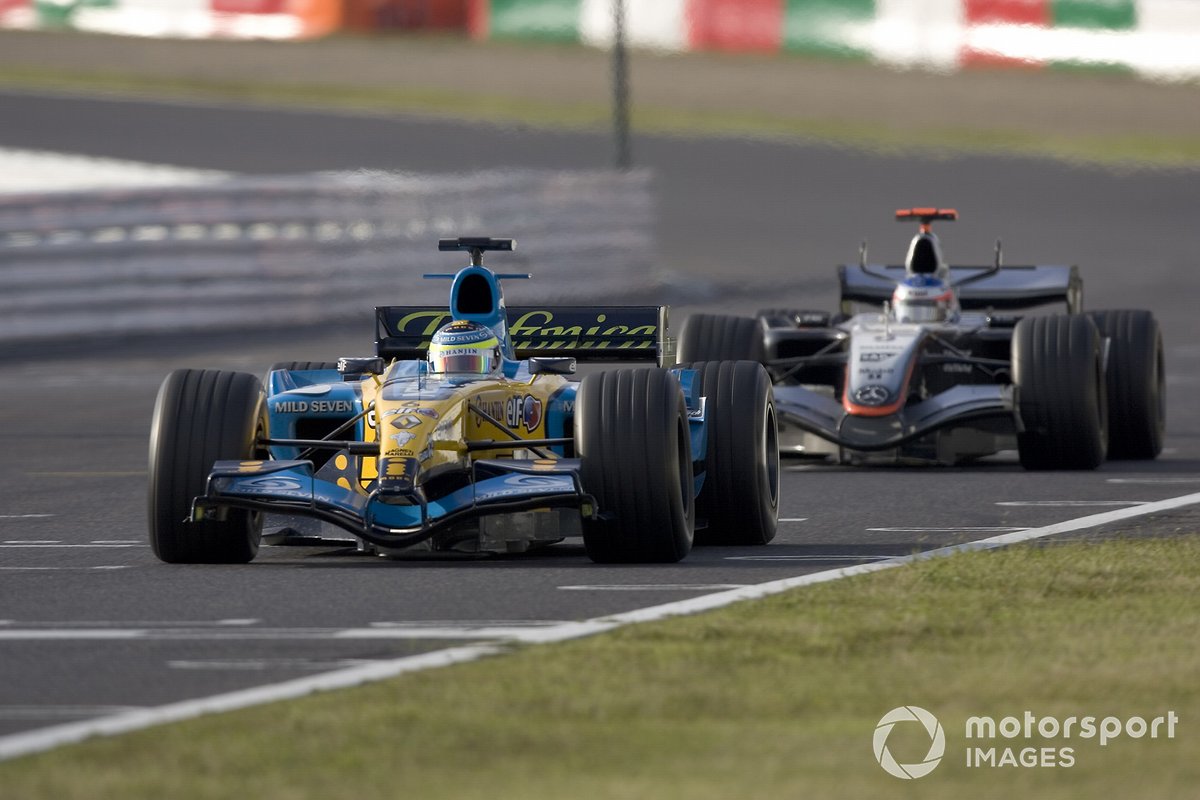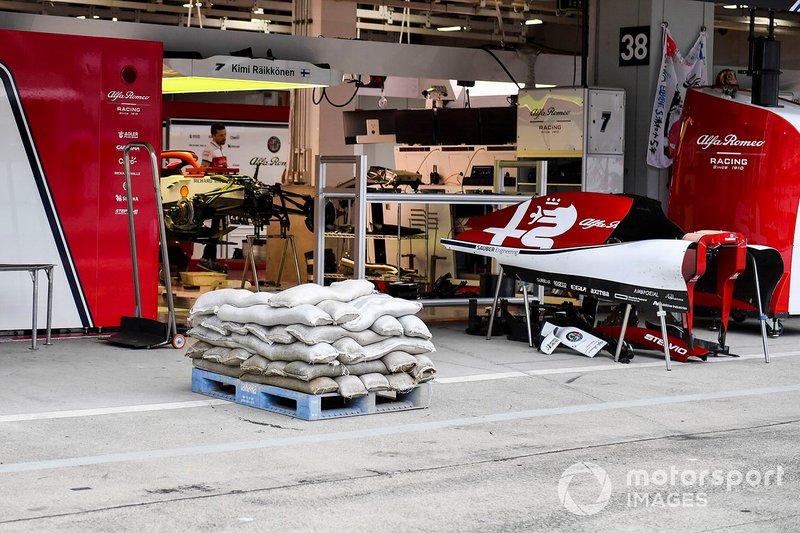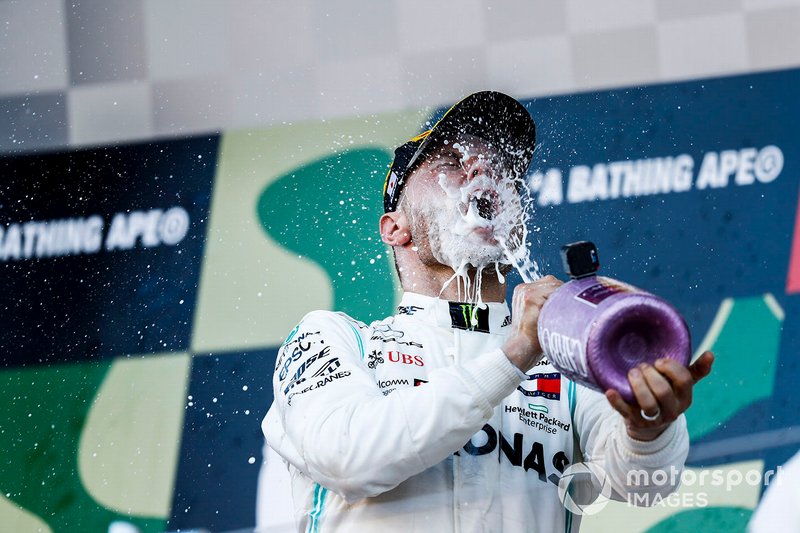
It may have been away for three years, but the Japanese Grand Prix remains a firm fans’ favourite – which also includes the Autosport team. From iconic title deciders to the unique setting and culture Formula 1 embraces on its trip to the far east, the race is awash of history and famous moments from across the years.
While perhaps best remembered for the controversial clashes between Ayrton Senna and Alain Prost in 1989 and 1990, neither of those races make the shortlist for our favourite Japanese GPs. Instead, a mix of other F1 legends, stunning race action and unforgettable moments fill this latest selection.
1994, Hill drives out of his skin to beat Schumacher in the rain - James Newbold

The 1994 Japanese Grand Prix, which yielded a drive Damon Hill cites as the race of his life, probably should never have been started. The spray engulfing the pack behind Michael Schumacher's Benetton as the field blasted towards Turn 1 was such that carnage was inevitable.
Johnny Herbert, running third in his first race for Benetton, Ukyo Katayama (Tyrrell) and Taki Inoue's Simtek floated into the barriers on the pitstraight, and after the restart the Minardis and Ligier rookie Franck Lagorce did likewise. The red flags only came after Martin Brundle aquaplaned off just before the first Degner, his McLaren narrowly avoiding a mini-caterpillar truck before striking a marshal attending to Gianni Morbidelli's wrecked Footwork, breaking his leg.
When the race was restarted, the race would become an aggregate affair with Williams driver Hill needing to overturn a 6.9s gap to his fierce title rival Schumacher over the final 37 tours. In his autobiography, Hill says he had been "driving out of my skin" in his attempts to keep up before the stoppage, "on the edge of my ability". But Schumacher was running a two-stop strategy and pitted soon after the restart, getting stuck in the spray of slower cars behind Hill, who made his one and only pit visit seven laps later.
After Schumacher took his second stop, Hill cycled back to the lead, but Schumacher made the advantage of his fresher tyres pay and began to close the gap. Hill, whose mechanics had been unable to change his sticking right-rear wheel during his stop, had to summon everything in his power to retain his aggregate advantage and a chance at reducing his five-point deficit in the standings with one race to go.
"It was almost as though I had let my instinct drive the car," he told Autosport in 2020 for the Race of My Life podcast. "It was an astonishing experience, driven by the championship situation. All my energy went into that performance."
PLUS: Top 10 Damon Hill F1 drives
In his book, Hill describes his driving on the final lap as "an observer of something phenomenal" in "what I suppose one could call an out-of-body experience in which I appeared to have totally surrendered trying to control the car myself. Everything seemed to be happening completely by instinct".
But it was enough. He won by 3.3 seconds, closing the title gap to one point ahead of the winner-takes-all finale in Adelaide. Behind, Jean Alesi just beat Nigel Mansell to third after a race-long scrap, despite the Williams driver passing his Ferrari rival at the end.
"You're completely mad," was Alesi's assessment, "but very quick for an old man!"
2000, Schumacher delivers gold for Ferrari - Alex Kalinauckas

It's hard not to pick this entry, given F1 legend Michael Schumacher chose it for his ‘Race of My Life’ selection for Autosport magazine shortly before suffering head injuries in a skiing accident in 2013. But it was also a tight and famous contest between of the championship’s best-ever drivers at the peak of their powers.
Race of my life: Michael Schumacher on the 2000 Japanese GP
After two near-misses in 1997 and 1998, plus the negative stand out campaigns of 1996 and 1999 due to poor machinery in the former and Schumacher’s broken leg in the latter, by 2000 it was starting to look as if the German’s story with the Scuderia might be one of failure.
Taking on the dominant McLaren/Mika Hakkinen since 1998, the Schumacher/Jean Todt/Ross Brawn/Rory Byrne superteam had come up short. But in a campaign that ebbed and flowed for both teams, with reliability and crash misfortune play big parts too – Ferrari finally grabbed its big chance in 2000.
Heading to Japan, Schumacher had taken momentum-shifting wins in Italy and the USA. At Suzuka, only Schumacher and Hakkinen were in contention – qualifying well ahead of their team-mates Rubens Barrichello and David Coulthard. Schumacher took pole but lost out to Hakkinen at the start, despite a typically aggressive chop across the fast-staring Finn’s bows, after which the contest was between them alone.
“For over 40 laps Mika and I did almost identical times, like a perpetual qualifying lap,” Schumacher said of the race, where keeping up pace in tricky drizzling conditions would decide the outcome.
Hakkinen led through the first of two pitstops, but after McLaren gave him a slightly-earlier-than-expected second service to avoid traffic the rain fell harder and Schumacher delivered three rapid laps out front.
Ferrari then produced a stop that gained him another 1.4s and he got to listen to Ross Brawn say “It's looking good, it's looking good… It's looking bloody good!” as he trundled agonisingly down the pitlane before emerging in the lead that he didn’t lose again.
Crossing the line 14 laps later, Schumacher slammed his steering wheel so hard in celebration Ferrari thought he’d broken it, so took it out of service for the season-ending Malaysian race. Five-years of pressure finally released.
2005, Raikkonen’s sensational burn from the stern - Charles Bradley

Kimi Raikkonen produced the finest drive of his Formula 1 career at Suzuka for McLaren in 2005, ripping his way through the field from 17th on the grid to pass the Renault of Giancarlo Fisichella on the very last lap to win.
Suzuka is known for being one of the hardest tracks to overtake around but even in this non-DRS era – which featured the odd combination of mid-race refuelling but no tyre changes – a mixed-up grid provoked an overtaking-fest with some epically brave passing moves.
This enthralling race was set up by wet-weather conditions that worsened throughout single-lap qualifying, so the top cars in the world championship started from the lower reaches of the grid: Ferrari’s Michael Schumacher was 14th, Renault’s Fernando Alonso 16th, Raikkonen 17th and team-mate Juan Pablo Montoya 18th.
Ralf Schumacher led from pole in his Toyota, ahead of Fisichella. Alonso and Raikkonen almost touched at the first corner as they swerved their way through the midfielders – with Montoya grabbing track position from Kimi. Raikkonen was further delayed when he locked up and straight-lined the Casio Triangle at the end of the opening tour, dropping to 14th. Montoya then crashed heavily right in front of him!
Schumacher and Raikkonen ran long on their first stints, taking first and second before they pitted to lap 27. They rejoined in fifth and sixth respectively.
Three laps later, Kimi stormed past Michael Schumacher on the run to Turn 1. That meant he led as those ahead pitted, until his own final stop on lap 46.
Fisichella retook the lead by 5.4s with eight laps remaining and, now on a similar fuel load and, of course, Michelin tyre life compared to Raikkonen, he appeared to be way out of reach. But Raikkonen had other ideas and aided by Fisichella taking a defensive line into the chicane at the end of the penultimate lap, he got a much better run on the exit. Kimi just managed to sweep around the outside of Fisi into Turn 1 on the final tour, their cars running just inches apart at top speed.
Raikkonen scored his most famous win by 1.6s, saying modestly of his last-lap pass: “After the second stop I had gained enough on Fisichella to go for it and I did. It was one of those opportunities you have to take.”
With the drivers’ title decided in his favour in Brazil the race before, an unburdened Alonso also tore through to finish on the podium. His highlight reel included a sensational pass on Michael Schumacher around the outside of 130R and overtaking Mark Webber into Turn 1 – with two wheels briefly on the grass! – to claim third place.
2011, Button outshines F1 world championship-clinching Vettel - Matt Kew

Although tempted to pick a Senna-Prost clash, I wasn’t born for those. But I do remember the hideously early alarm call and the quality of Jenson Button’s 2011 drive to victory that came a few hours later.
Sebastian Vettel was in his pomp and arriving at Suzuka, only needed a point to claim his second world title over Button with four rounds to spare. That was the bigger picture. But where the race was concerned, the Brit had been playing up his connection to the Japanese fans this weekend, helped by his first marriage and prior links to Honda. Naturally, back when design changes were seemingly constant, he wore a special helmet for the occasion - later auctioned to raise money for the tsunami relief effort.
Having qualified second for the dry race, falling short by just 0.009s in the McLaren, he was squeezed by polesitter Vettel onto the grass before working wonders with an overcut strategy to take the lead. As the Red Bull was stymied by tyre degradation, Button turned in a pivotal in-lap 1.4s quicker than his rivals Vettel and Fernando Alonso to decide the bout.
While this wasn’t a vintage encounter, it was his management at the front that sticks out. He blitzed clear prior to a safety car and then after, was happy to let Alonso close to within a second with just a handful of laps to go. Then Button lit the touch paper and just had an answer to everything the Ferrari could throw to eventually claim the spoils by 1.2s.
PLUS: Jenson Button’s 10 greatest F1 races ranked
Suzuka is not renowned for overtaking, and this wasn’t a thriller for unlikely passes. But perhaps because it came in the middle of an era of Vettel dominance, Button’s own dominance that day has always held a soft spot when it comes to reviewing his career, and the best Japanese GPs.
2019, Saturday no-show sets up super Sunday show - Luke Smith

The 2019 Japanese Grand Prix is not a race that will live long in the memory. But the quirks of the weekend mean it stands out as one of my personal favourites from my time covering Formula 1.
The threat of Typhoon Hagibis had already forced two Rugby World Cup matches to get called off, and with Suzuka set to be impacted on Saturday, the FIA took an early call on Friday morning to announce that qualifying would be bumped to Sunday morning. No-one was to enter the track on Saturday, and as I completed a track run on the Friday after FP2 with the winds picking up, staff were going around removing all of the hoardings and tying down anything that could be blown away.
Knowing Saturday was a write-off, the local karaoke bar in Shiroko, a small town near Suzuka where much of the paddock stays, was buzzing on Friday night. Some good news followed on Saturday morning when we woke up to find the typhoon had gone off course a bit, meaning that bar it being windy and wet, no damage would be done to the immediate area.
It set up a super Sunday of F1 action under perfect blue skies. Qualifying in the morning saw Sebastian Vettel lead a Ferrari front row lockout, only for the race to quickly fall away from the team. Vettel’s jump start was small enough to not trigger the FIA sensors, but his bid to save it compromised his getaway, allowing Valtteri Bottas to take the lead.
After the race, Bottas and team-mate Lewis Hamilton struggled to hold in their laughter when Vettel denied he had any thoughts about getting a penalty for it. “You’re lying, come on!” said Hamilton, but Vettel brushed it off: “If you jump the start then obviously you get caught, so I think it was just fine.” Yeah, right…
With Charles Leclerc also out of the picture after his clash with Max Verstappen, the damage forcing him to take 130R one-handed to stop his mirror flying away, it was a comfortable win for Bottas that clinched Mercedes the constructors’ title and put all bar himself or Hamilton out of contention for the drivers’ crown.
The Sunday showed the perks of having a day crammed with F1 action. The Japanese fans are known for their loyalty and support, and the atmosphere at Suzuka was as electric as ever. That excitement will not have waned one bit in last the three years away.








